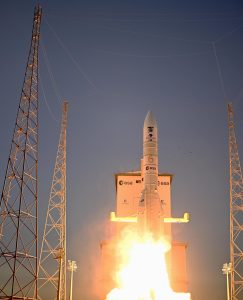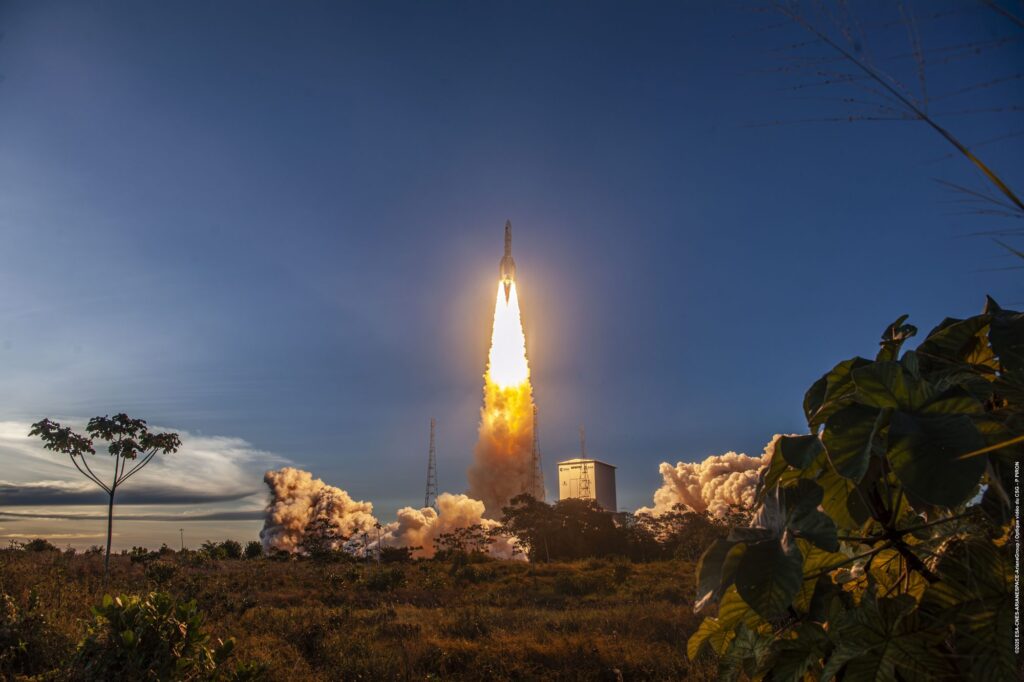Europe has successfully launched its newest Copernicus satellite, Sentinel 1D, marking a major milestone in Earth observation and space autonomy.
The satellite was launched on November 4, 2025 at 22:02 CET (21:02 UTC) aboard an Ariane 6 rocket from the European spaceport in Kourou, French Guiana.
After 34 minutes, Sentinel 1D was released into orbit and at 23:22 CET the first signal was received at the Troll ground station in Antarctica, confirming the successful deployment of the Copernicus satellite.
This launch ensures the continuation of Europe’s world-leading radar-based Earth observation system, which continues to monitor the Earth at all times, day and night, and in all weather conditions.
Commenting on the successful launch, Simonetta Celli, Head of the European Space Agency’s (ESA) Earth Observation Program, said: “This launch on Ariane 6 is important for ESA as it completes the mission of Copernicus Sentinel 1. Sentinel 1D will soon be commissioned and fully operational alongside Sentinel 1C.”
“The continuity of services this provides to the EU space program is essential to meeting the global challenges we face.
“The public will benefit as this mission contributes to the scientific understanding of our environment by providing accurate, reliable and actionable radar data on ice sheet movement, forest ecosystems, ground movement and more.
“I would like to thank all the teams involved, from the ESA mission team, to our many partners in European industry, including Thales Alenia Space, Airbus Defense and Space, and of course the European Commission, our partner in the Copernicus program.”
Strengthening European radar vision
The new Copernicus satellite will take over from Sentinel 1A, which has been in operation since 2014, extending the mission’s capabilities into the next decade.
Developed under the EU Space Program in cooperation with ESA, Sentinel-1D forms part of the Sentinel-1 constellation, famous for its high-resolution synthetic aperture radar (SAR) imagery.
Unlike optical satellites, Sentinel-1D’s radar can see through clouds, darkness, and even rain, providing uninterrupted global coverage. Its radar equipment provides critical data for environmental monitoring, maritime surveillance and rapid emergency response.
Watching the changing earth
Sentinel-1D data is used to detect oil spills, track illegal maritime activities, and monitor natural disasters such as floods, landslides, volcanic eruptions, and earthquakes.

It also supports agricultural and forestry management, mapping land change, and observing the effects of climate change on glaciers, ice sheets, and coastlines.
The Copernicus satellite carries both C-band SAR equipment and an Automatic Identification System (AIS) to track ships at sea. Together, these tools will enhance maritime safety and environmental protection.
The onboard Galileo-enabled navigation receiver will also strengthen Europe’s space independence and ensure accurate positioning without dependence on non-European systems.
Team up with Sentinel-1C
Sentinel-1D will soon join its twin, Sentinel-1C, in orbit. The two satellites will operate 180 degrees apart on opposite sides of the globe, optimizing global coverage and ensuring frequent revisit times.
The two companies will work together to deliver an uninterrupted flow of radar imagery and vessel tracking data to users around the world.
Once fully calibrated, Sentinel-1D will begin providing free and open data to governments, research institutions, and private companies to support applications ranging from environmental protection to security to sustainable development.
Proven technology that impacts the world
Since the first Sentinel 1 satellite was launched more than a decade ago, the Copernicus program has transformed the way scientists and decision makers observe the Earth.
Its radar data revealed land subsidence across Europe, tracked tropical deforestation under thick cloud cover, and measured ice loss in the Arctic and Antarctic.
Sentinel-1 data is also critical to disaster response, from mapping flooding beneath Greenland’s ice sheet to monitoring earthquakes and large-scale methane leaks.
This vast, freely available dataset has become essential to climate scientists, environmental agencies, and emergency responders around the world.
Victory for European cooperation
The Sentinel-1D mission is the result of many years of cooperation between the European Commission, ESA and European industry.
More than 70 companies, led by Thales Alenia Space and Airbus Defense and Space, contributed to the design and construction, demonstrating Europe’s commitment to technological excellence and sustainable innovation.
With the Copernicus satellite Sentinel 1D now safely in orbit, Europe continues to build on its global leadership in Earth observation.
This mission will not only ensure the continuity of critical environmental data, but also strengthen Europe’s resilience, autonomy and ability to respond quickly to global challenges.
Sentinel-1D will undergo a rigorous commissioning phase over the next few months before entering full-scale operations.
Once activated, it will provide the world with an unblinking radar eye on Earth, tracking Earth’s movements, monitoring the oceans, and helping humanity better understand and protect our only home.
Source link

